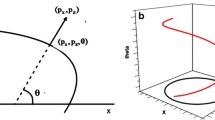Abstract
Numerical examples of high-frequency synthetic seismograms of body waves in a 2-D layered medium with complex interfaces (faults, wedges, curvilinear, corrugated) are presented. The wave field modeling algorithm combines the possibilities of the ray method and the edge wave superposition method. This approach preserves all advantages of the ray method and eliminates restrictions related to diffraction by boundary edges and to caustic effects in singular regions. The method does not require two-point ray tracing (source-to-receiver), and the position of the source, as well as the type of source, and the position of receivers can be chosen arbitrarily. The memory and the time required for synthetic seismogram computation are similar to ray synthetic seismograms. The computation of the volume of the medium (the Fresnel volume or Fresnel zones), which gives the essential contribution to the wave field, is included in the modeling program package. In the case of complicated irregular interface (or a layered medium with a regular ray field at the last interface), the method displays a high accuracy of wave field computation. Otherwise, the method can be considered a modification of the ray method with regularization by the superposition of edge waves.
Similar content being viewed by others
References
Aizenberg, A. M., andKlem-Musatov, K. D. (1980),Calculation of Wave Field by the Method of Superposition of Edge Waves, Soviet Geol. and Geophys.21 (6), 79–94 (in Russian).
Aizenberg, A. M. (1993),A System of Irregular Fundamental Solution to Wave Equation in a 3-D Inhomogeneous Medium, Soviet Geol. and Geophys.34 (4), 119–127 (in Russian).
Alekseev, A. S., andGelchinsky, B. Ya.,On the ray method of computation of wave field for inhomogeneous media with curved interfaces. InProblems of the Dynamic Theory of Propagation of Seismic Waves (ed. Petrashen, G. I.) (Leningrad Univ. Press, Leningrad 1959) Vol. 3, pp. 107–160 (in Russian).
Alekseev, A. S., Babich, V. M., andGelchinsky, B. Ya.,Ray method in computation of the wave field intensity. InProblems of the Dynamic Theory of Propagation of Seismic Waves (ed. Petrashen, G. I.) (Leningrad Univ. Press, Leningrad 1961) Vol. 5, pp. 3–24 (in Russian).
Born, M., andWolf, E.,Principle of Optics (Pergamon Press, Oxford 1968).
Červený, V., Molotkov, I. A., andPšenčík, I.,Ray Method in Seismology (Karlova Universita, Praha 1977).
Červený, V. (1985),Gaussian Beam Synthetic Seismograms, J. Geophys.58, 44–72.
Fock, V. A.,Electromagnetic Diffraction and Propagation Problems (Pergamon Press, New York 1965).
Hilterman, F. J. (1982),Interpretative Lessons from Three-dimensional Modelling, Geophys.47, 784–808.
Keller, J. B. (1962),A Geometrical Theory of Diffraction, J. Opt. Soc. Am.52, 116–130.
Klem-Musatov, K. D.,The Theory of Edge Waves and its Applications in Seismology (Nauka, Novosibirsk 1980) (in Russian).
Klem-Musatov, K. D., andAizenberg, A. M. (1984),Ray Method and the Theory of Edge Waves, Geophys. J. R. Astr. Soc.79, 35–50.
Klem-Musatov, K. D., andAizenberg, A. M. (1985),Seismic Modelling by Methods of the Theory of Edge Waves, J. Geophys.57, 90–105.
Kravstov, Yu. A., andOrlov, Yu. I.,Geometrical Optics of Inhomogeneous Media (Nauka, Moscow 1980) (in Russian).
Luneva, M. N.,Influence of Interface Geometry on the Dynamics of Transmitted Wave (DVO AN USSR, Vladivostok 1992) (in Russian).
Luneva, M. N., andChang, Y. F. (1995),Scattering of Elastic Waves by a Thin Soft Layer, J. Seismic Exploration4, 17–32.
Mikhalenko, B. G.,Scattering Field in Complex Media (Atlas of Snapshots and Synthetic Seismograms) (AN USSR, Siberian Branch, Computing Center, Novosibirsk 1988) (in Russian).
Popov, M. M.,A new method of computation of wave fields in high-frequency approximation. InNotes of Scientific Workshop LOMI (LOMI, Leningrad 1981)104, pp. 195–216 (in Russian).
Trorey, A. W. (1977),Diffraction for Arbitrary Source-receiver Locations, Geophys.42, 1177–1182.
Author information
Authors and Affiliations
Rights and permissions
About this article
Cite this article
Luneva, M. Application of the edge wave superposition method. PAGEOPH 148, 113–136 (1996). https://doi.org/10.1007/BF00882057
Received:
Revised:
Accepted:
Issue Date:
DOI: https://doi.org/10.1007/BF00882057



